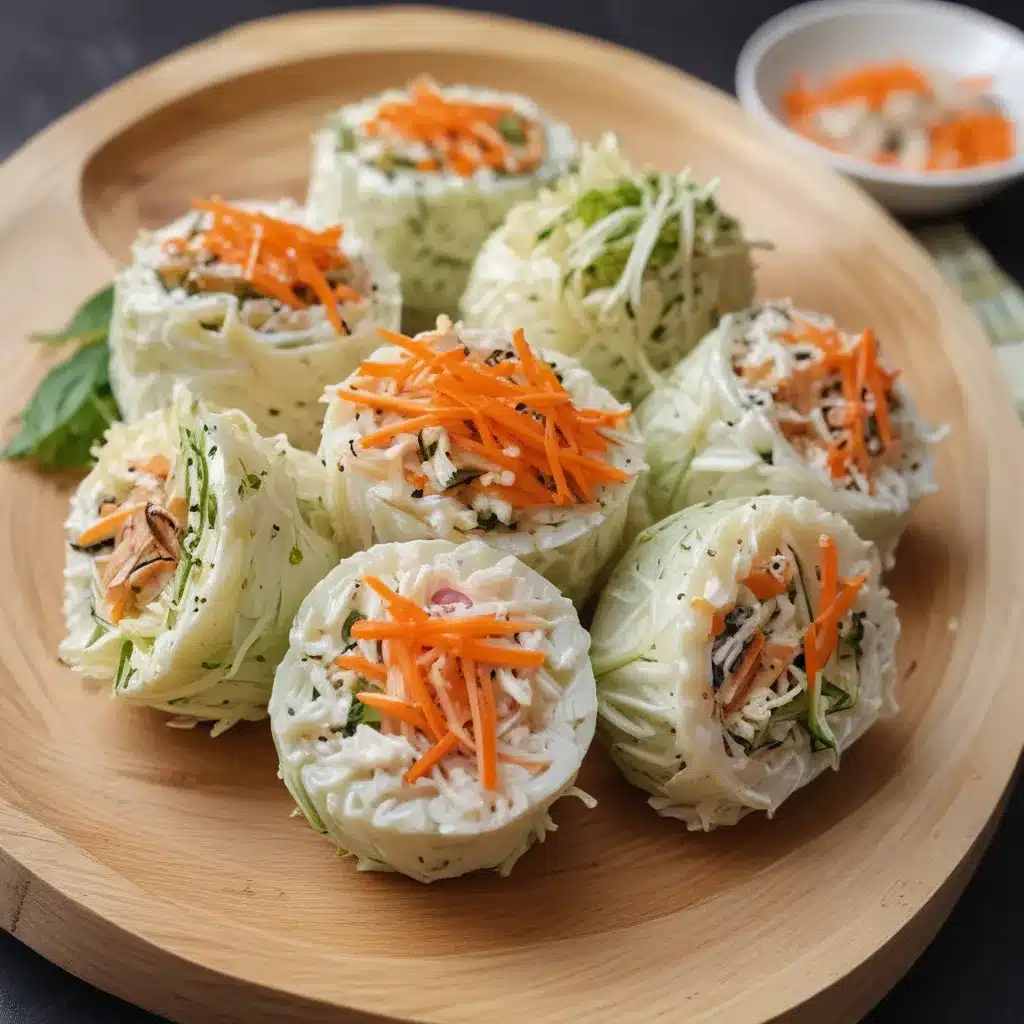
Gimbap and the Joys of Culinary Contrasts
As I stroll down the bustling streets of Boston’s Koreatown, the aroma of freshly prepared gimbap wafts through the air, beckoning me to indulge in this beloved Korean delicacy. Gimbap, often referred to as the “sushi of Korea,” is a delightful roll that combines an array of flavorful ingredients, each contributing its own unique texture and taste. But have you ever considered the joy of pairing this savory treat with a cool, creamy coleslaw?
You see, I’m a firm believer that the true magic in Korean cuisine lies in the interplay of contrasting elements. It’s about striking a perfect balance between the soft and the crunchy, the sweet and the savory, the bold and the subtle. And what better way to experience this harmonious dance than by enjoying a plate of gimbap accompanied by a generous dollop of creamy coleslaw?
The Allure of Coleslaw: A Creamy Foil to Gimbap’s Texture
Now, I know what you’re thinking – coleslaw? With my beloved gimbap? Hear me out, my friend. Coleslaw, with its delightfully crisp shredded cabbage and carrots, can be the perfect complement to the soft, chewy texture of gimbap. The creamy, tangy dressing provides a refreshing counterpoint to the seaweed-wrapped rice and fillings.
Imagine taking a bite of the gimbap, the flavors bursting on your tongue, only to follow it up with a cool, creamy mouthful of coleslaw. The interplay of textures and temperatures creates a truly remarkable dining experience, one that will leave you wondering why you haven’t been pairing these two Korean staples together all along.
The Art of Crafting the Perfect Coleslaw
Of course, not all coleslaws are created equal. To truly elevate the gimbap-coleslaw pairing, it’s essential to master the art of crafting the perfect coleslaw.
Now, I know what you’re thinking – how hard can it be to make a simple coleslaw? Well, let me tell you, there’s a whole world of nuance and technique involved in creating a coleslaw that can truly complement the flavors of gimbap.
First and foremost, the key is to strike the right balance between the creamy dressing and the crisp, crunchy vegetables. Too much dressing, and you’ll end up with a soggy, heavy mess. Too little, and the coleslaw will lack the necessary creaminess to offset the gimbap’s texture.
Mastering the Coleslaw Dressing
The dressing is where the real magic happens. A traditional coleslaw dressing is typically a simple blend of mayonnaise, vinegar, and a touch of sugar. But in my quest to create the ultimate gimbap-coleslaw pairing, I’ve experimented with a few twists on the classic recipe.
One of my favorite variations involves a touch of Korean gochujang, the ubiquitous fermented chili paste that adds a delightful complexity to any dish. The subtle heat and umami notes of the gochujang complement the cool, creamy base of the dressing perfectly, creating a flavor profile that both enhances and contrasts the gimbap.
Another secret weapon in my coleslaw arsenal is a splash of rice vinegar. This milder, slightly sweeter vinegar adds a delicate tanginess that plays beautifully with the creaminess of the dressing, without overpowering the delicate flavors of the gimbap.
The Importance of Texture and Crunch
But the dressing is only half the battle. The other key component in crafting the perfect coleslaw is, of course, the vegetables themselves. While the traditional combination of shredded cabbage and carrots is a solid foundation, I like to take it a step further by incorporating a few unexpected elements.
For instance, have you ever tried adding thinly sliced radish or jicama to your coleslaw? These crunchy, juicy veggies not only add a lovely pop of color to the dish, but they also provide a delightful textural contrast to the soft, chewy gimbap.
And let’s not forget about the importance of a proper shred. I’m talking about ribbons of cabbage and carrots that are crisp, yet tender – not too thick and not too thin. The ideal coleslaw should provide a satisfying crunch with every bite, creating a dynamic interplay with the gimbap’s smooth, velvety textures.
The Gimbap-Coleslaw Harmony
So, the next time you find yourself craving the comforting flavors of gimbap, I urge you to take a moment to consider the potential of pairing it with a creamy, crunchy coleslaw. It’s a match made in culinary heaven, a yin-yang of textures and tastes that will elevate your gimbap experience to new heights.
Imagine taking that first bite, the gimbap’s seaweed wrapper giving way to the soft, fragrant rice and your choice of fillings – perhaps some spicy tuna, fragrant spinach, or savory beef. As you savor the flavors, let your palate be awakened by the cool, creamy coleslaw, its crunchy vegetables providing a delightful counterpoint to the gimbap’s smooth, velvety texture.
It’s a harmony of contrasts that will have your taste buds doing a joyful dance, each bite a new adventure in the realm of Korean cuisine. So, what are you waiting for? Grab a plate of gimbap and pair it with a generous serving of homemade creamy coleslaw – your taste buds will thank you.
And if you’re feeling particularly adventurous, why not explore the world of Korean cuisine even further? Visit Korean Garden Boston to discover a mouthwatering array of authentic Korean dishes, from savory bulgogi to fragrant bibimbap. Trust me, your culinary journey is about to get a whole lot more exciting.
